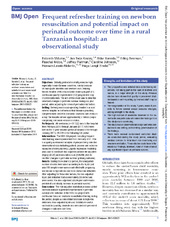Frequent refresher training on newborn resuscitation and potential impact on perinatal outcome over time in a rural Tanzanian hospital: An observational study
Mduma, Estomih; Kvaløy, Jan Terje; Søreide, Eldar; Svensen, Erling; Mdoe, Paschal Francis; Perlman, Jeffrey; Johnson, Caroline Amy; Hussein, Kidanto; Ersdal, Hege Langli
Peer reviewed, Journal article
Published version

Åpne
Permanent lenke
https://hdl.handle.net/1956/23534Utgivelsesdato
2019Metadata
Vis full innførselSamlinger
Originalversjon
https://doi.org/10.1136/bmjopen-2019-030572Sammendrag
Objectives: Globally, perinatal mortality remains high, especially in sub-Saharan countries, mainly because of inadequate obstetric and newborn care. Helping Babies Breathe (HBB) resuscitation training as part of a continuous quality improvement (CQI) programme may improve outcomes. The aim of this study was to describe observed changes in perinatal survival during a 6-year period, while adjusting for relevant perinatal risk factors. Setting: Delivery rooms and operating theatre in a rural referral hospital in northern-central Tanzania providing comprehensive obstetric and basic newborn care 24 hours a day. The hospital serves approximately 2 million people comprising low social-economic status. Participants: All newborns (n=31 122) born in the hospital from February 2010 through January 2017; 4893 were born in the 1-year baseline period (February 2010 through January 2011), 26 229 in the following CQI period. Interventions: The HBB CQI project, including frequent HBB training, was implemented from February 2011. This is a quality assessment analysis of prospectively collected observational data including patient, process and outcome measures of every delivery. Logistic regression modelling was used to construct risk-adjusted variable life adjusted display (VLAD) and cumulative sum (CUSUM) plots to monitor changes in perinatal survival (primary outcome). Results: During the 6-year CQI period, the unadjusted number of extra lives saved according to the VLAD plot was 150 despite more women admitted with pregnancy and labour complications and more caesarean deliveries. After adjusting for these risk factors, the risk-adjusted VLAD plot indicated that an estimated 250 extra lives were saved. The risk-adjusted CUSUM plot confirmed a persistent and steady increase in perinatal survival. Conclusions: The risk-adjusted statistical process control methods indicate significant improvement in perinatal survival after initiation of the HBB CQI project with continuous focus on newborn resuscitation training during the period, despite a concomitant increase in high-risk deliveries. Risk-adjusted VLAD and CUSUM are useful methods to quantify, illustrate and demonstrate persistent changes in outcome over time.
